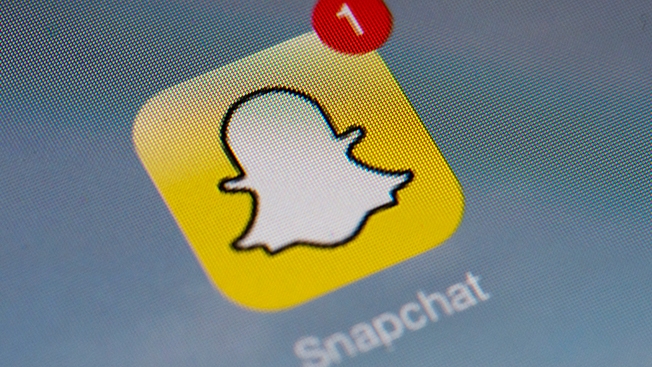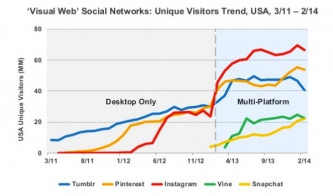14 Digital Trends on Kleiner Perkins' Venture Capital Radar
Mary Meeker on who shall inherit the Web By Garett Sloane- May 28, 2014, 2:10 PM EDT
- Technology

Photo: Getty Images
Snapchat and WhatsApp both account for 700 million photos shared daily. The average Google user is six times more valuable than the average Facebook user. Buzzfeed is big on Facebook but not as big on Twitter, where BBC is the top media brand. And 25 percent of global Internet use is on mobile, but only 4 percent of ad dollars is.
These are just some of the key Web trends that Mary Meeker of VC firm Kleiner Perkins Caufield & Byers shared at Re/Code’s conference today. Here is part of the 164-page State of the Internet report and what the top investment firm is looking at when it makes its billion-dollar bets on the future:
Messaging services
They’re called “over the top” messaging services, a category that includes Snapchat, WhatsApp, Line, We Chat, Viber and KakaoTalk. In less than five years, a billion people will be using them.
Snapchat
The app serves 1.2 billion messages a day (700 million “snaps” and 500 millionSnapchat “stories.”) WhatsApp users share 50 billion a day and Line users (big in Japan) share 10 billion.
The app serves 1.2 billion messages a day (700 million “snaps” and 500 millionSnapchat “stories.”) WhatsApp users share 50 billion a day and Line users (big in Japan) share 10 billion.
Facebook’s photo play
Why did Facebook pay $1 billion for Instagram and $19 billion for WhatsApp? Because it now controls more than 1.1 billion photos shared daily between the three services, compared to Snapchat’s 700 million.
Why did Facebook pay $1 billion for Instagram and $19 billion for WhatsApp? Because it now controls more than 1.1 billion photos shared daily between the three services, compared to Snapchat’s 700 million.
Web trends
A look at emerging players shows that Snapchat and Twitter’s Vine now have an equal number of monthly unique visitors, more than 20 million. This year, Tumblr, Pinterest, Vine and Instagram have seen a downtick in monthly users, according to comScore. Snapchat users were increasing as of February.
A look at emerging players shows that Snapchat and Twitter’s Vine now have an equal number of monthly unique visitors, more than 20 million. This year, Tumblr, Pinterest, Vine and Instagram have seen a downtick in monthly users, according to comScore. Snapchat users were increasing as of February.
Mobile
On mobile, apps still dominate in revenue, over advertising. In 2013, mobile revenue totaled $38 billion, and less than $15 billion came from advertising.
On mobile, apps still dominate in revenue, over advertising. In 2013, mobile revenue totaled $38 billion, and less than $15 billion came from advertising.
Mobile ad potential
20 percent of media consumption in the U.S. is on mobile, but only 4 percent of ad dollars are allocated there. Kleiner Perkins calls that a nearly $30 billion opportunity.
20 percent of media consumption in the U.S. is on mobile, but only 4 percent of ad dollars are allocated there. Kleiner Perkins calls that a nearly $30 billion opportunity.
Google, Facebook and Twitter
Google is killing Facebook and Twitter when it comes to the amount of money it makes from each user. Average revenue per Google user is $45, the average for a Facebook user is $7.24, and the average on Twitter is $3.55.
Google is killing Facebook and Twitter when it comes to the amount of money it makes from each user. Average revenue per Google user is $45, the average for a Facebook user is $7.24, and the average on Twitter is $3.55.
Desktop versus mobile
Global Internet advertising was $116 billion last year, more than $100 billion of which went to desktop. However, 25 percent of Web usage is on mobile now.
Global Internet advertising was $116 billion last year, more than $100 billion of which went to desktop. However, 25 percent of Web usage is on mobile now.
Facebook publishers
The top three Facebook publishers by number of shares, comments and Likes: Buzzfeed, Huffington Post and ABC News.
The top three Facebook publishers by number of shares, comments and Likes: Buzzfeed, Huffington Post and ABC News.
Twitter publishers
The top three Twitter publishers by number of shares: BBC, New York Times and Mashable
The top three Twitter publishers by number of shares: BBC, New York Times and Mashable
Buzzfeed phenomenon
130 million monthly visitors, 50 percent mobile, 75 percent social, 50 percent ages 18 to 34.
130 million monthly visitors, 50 percent mobile, 75 percent social, 50 percent ages 18 to 34.
Tinder dating
The dating app makes 11 million matches of men and women a day, up 21 percent year over year.
The dating app makes 11 million matches of men and women a day, up 21 percent year over year.
Digital music
In 2013, digital track sales declined 6 percent to 1.3 billion tracks, the first ever down year. However, music streaming was up 32 percent, 118 billion songs last year, showing streaming services are in demand (like Beats, which Apple is looking to buy).
In 2013, digital track sales declined 6 percent to 1.3 billion tracks, the first ever down year. However, music streaming was up 32 percent, 118 billion songs last year, showing streaming services are in demand (like Beats, which Apple is looking to buy).
Social TV
Twitter’s second screen strategy is working for advertisers: 53 percent of TV viewers re-exposed to a brand’s message on Twitter recalled the ad, while 40 percent of TV-only consumers recalled the ad. Similar boosts were experienced when asking about brand favorability and purchase intent.
Twitter’s second screen strategy is working for advertisers: 53 percent of TV viewers re-exposed to a brand’s message on Twitter recalled the ad, while 40 percent of TV-only consumers recalled the ad. Similar boosts were experienced when asking about brand favorability and purchase intent.



 Our content curation objectives focus on keeping our broader prospect/customer/partner/pipeline network engaged with value-added content. We also hope it helps drive increased, pass-along awareness for other brands.
Our content curation objectives focus on keeping our broader prospect/customer/partner/pipeline network engaged with value-added content. We also hope it helps drive increased, pass-along awareness for other brands.


